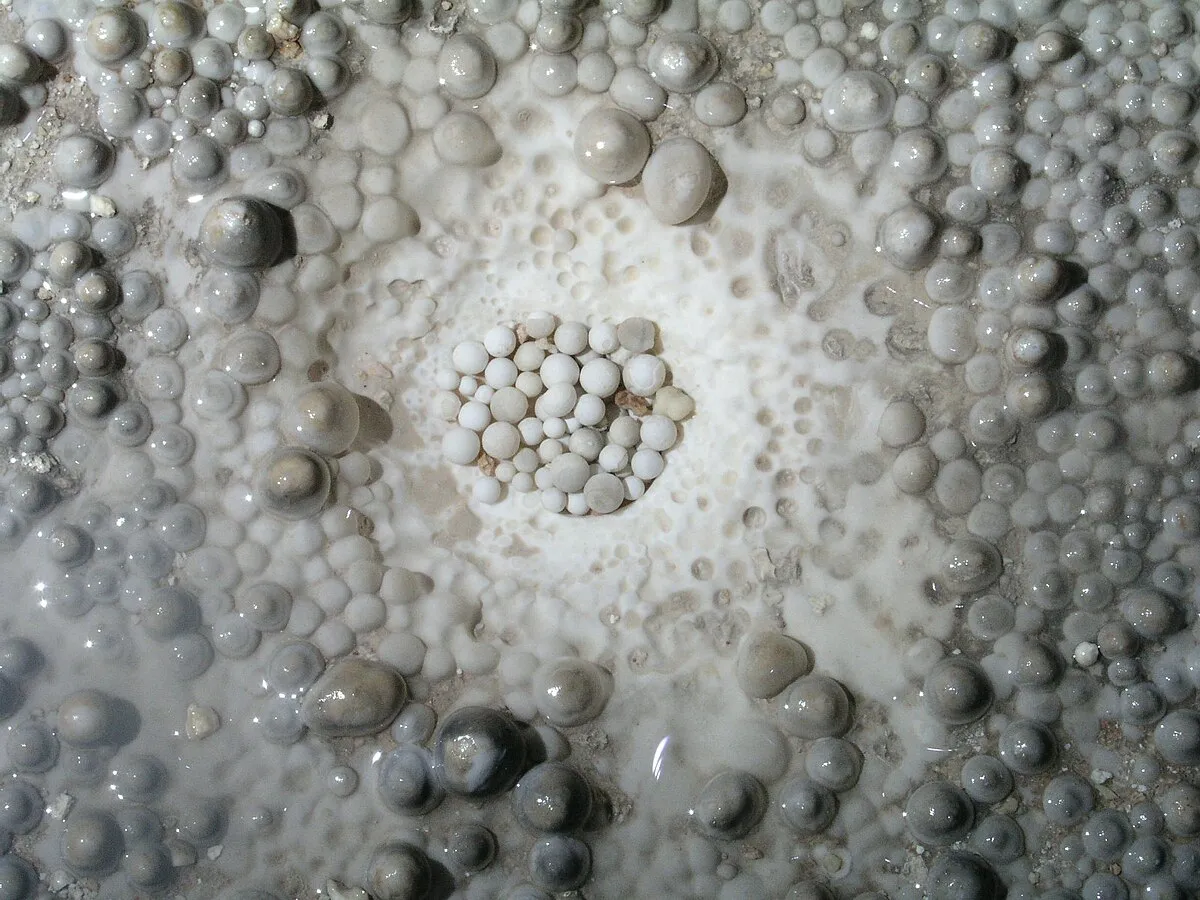Today I am taking you pearl hunting! No, no, don't put your diver's suit on! This time our pearl hunt will be underground as we will be looking for cave pearls!

Image from: commons.wikimedia.org - Courtesy of: WTucker - License: Licensed under the GFDL by the author; GFDL-SELF-NO-DISCLAIMERS; Released under the GNU Free Documentation License.
Not necessarily... at least considering the shape of them!
Cave pearls are not real pearls, they are made of calcium salts (mainly calcite) inside limestone caves and sometimes in mines. They are basically one type of speleothems (a cool Greek-deriving word for in-cave formations like stalactites and stalagmites). Other than calcite, cave pearls may contain traces of "quartz, apatite, iron, aluminum, and magnesium" . [1]
Another name for them is cave pisoids and despite the word pearl in their name, they are not the ideal jewellery material. Being more porous than real pearls, they turn out to be fragile and can't be used to make jewellery. [1, 2, 8]
Yes, in some cases they do!
Cave pearls have a "smooth, lustrous surface and regular concentric lamination" [3]. This means they are shiny spheres that grow concentrically as mineral layers "accumulate" over the original nucleus. They are basically spherical, but it's not the only shape they can take cylindrical, elliptical or why not, cubical and hexagonal shapes. Their sizes range from 1-20 cm, with the biggest cave pearls ever recorded being found in Vietnam, in the Son Doong Cave (wikipedia says they were the size of a baseball). They are not to be considered oolites (a sedimentary rock also composed mainly of calcium carbonate) and their chemical composition is such that any contact with the air might cause them to loose their "smoothness" and become rough. [1, 3, 4, 6]
Based on observations we can say we have a "model" considering their appearance:
As saturated water makes it inside a cave and loses CO2, it causes the precipitation of minerals. When these minerals find a free nuclei, they gather around it and little by little form beautiful spherical shapes. The minerals are deposited in layers and are usually "calcium carbonate (calcite or aragonite – CaCO3), or calcium sulphate (gypsum – CaSO4 2H2O)" [5]. The constant dribbling water movement needs to retain a certain "speed" (not too fast to destroy the sphere, neither too slow for the sphere to "stick" on the pool floor), the nucleus then keeps rolling around the flat pool inside the cave and it is this movement that gives the characteristic spherical shapes to the pearls (it grinds them and makes them characteristically round). Once they grow over a certain size, the water is not "strong" enough to keep rolling them around and they start to get "cemented" on the pool floor. [5]
Keep in mind that if the water was dripping a liiittle more slowly, then we would have a pretty stalagmite instead. [6]

Image from: commons.wikimedia.org - Courtesy of: Darkbluejacket - License: CC BY-SA 3.0
Observations of cave pearls in Perlova Cave (Slovakia) focused on the role of bacteria in the formation of cave pearls of irregular shapes. These cave pearls do not grow as spheres around a nucleus and a thin biofilm was found on their outer layers consisting of " live microbial cells, their extracellurar polymeric substances and a mineral fraction" [3]. The mineral fractions were mainly calcitic replicas of microbes, which means that living or dead microbes were calcified in order to act as a nucleus for the cave pearls. Calcite crystals then started growing over them and create the cave pearls. Chemolithoautrophic hydrogen-oxidising bacteria also seem to play an important role in the calcification process here, as they consumed CO2 and lead to calcite secretion within the pearl's "body". [3, 7]
The biofilm on the surface plays a role too. The biofilm is responsible for the calcite precipitation in the water and causes the "embodiment" of non-calcite mineral grains within the pearl. It also works as a protective "shield" for the pearl when disturbances (like a change in the water's pH) occur. [3, 7]
(For more details on the role of bacteria, you can go through the 3rd link in the references.)
There is a theory suggesting that cave pearls may be able to reveal secrets about climate changes in the past. Measurements in the oxygen isotope ratios inside them would probably provide interesting data, but the method is still under examination. [5]
To find cave pearls you need to find... a limestone cave first 😜
There are two caves in America though that are famous for having more cave pearls than any other cave in the world: the Cave of Marbles (Tabasco, Mexico) that is estimated to hide about 200 million pearls inside it and the Carlsbad Caverns (New Mexico, US), also known as the Rookery. [5]
(Click on the Cave of Marbles link, the photos will surely impress you!)
[1] wikipedia.org
[2] pubs.geoscienceworld.org
[3] sbe.com.br
[4] goodearthgraphics.com
[5] the-earth-story.com
[6] worldatlas.com
[7] researchgate.net
[8] langantiques.com

Until my next post,
Steem on and keep smiling, people!

